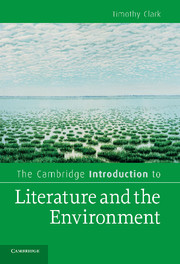Book contents
- Frontmatter
- Contents
- List of illustrations
- Preface
- Acknowledgements
- Introduction
- Romantic and anti-romantic
- The boundaries of the political
- Science and the struggle for intellectual authority
- The animal mirror
- Chapter 18 Ethics and the non-human animal
- Chapter 19 Anthropomorphism
- Chapter 20 The future of ecocriticism
- Notes
- Further reading
- Index
- Cambridge Introductions to …
Chapter 19 - Anthropomorphism
Published online by Cambridge University Press: 05 June 2012
- Frontmatter
- Contents
- List of illustrations
- Preface
- Acknowledgements
- Introduction
- Romantic and anti-romantic
- The boundaries of the political
- Science and the struggle for intellectual authority
- The animal mirror
- Chapter 18 Ethics and the non-human animal
- Chapter 19 Anthropomorphism
- Chapter 20 The future of ecocriticism
- Notes
- Further reading
- Index
- Cambridge Introductions to …
Summary
Anthropomorphism, the concept seems easy, even self-evident. Anthropomorphism is ‘the attribution [usually falsely] of a human form or personality to a god, animal, or thing’ (Illustrated Oxford Dictionary). The issue has recurred at key points in this book. It related to what may be the inherently anthropocentric nature of human language, projecting as it does a world usually understood according to our own scale, dimensions, interests and desires (see Third Quandary in Chapter 4). Alternatively, language that may seem problematically figurative or ‘merely anthropomorphic’ can also acquire provocative value as a way of doing justice to the agency of the non-human, as in Haraway's naming nature ‘coyote’ or even Cheney's talk of the ‘watchfulness’ of rocks. Finally, in this last chapter the category of ‘anthropomorphism’ is considered in relation to ethical questions of the just representation of the non-human. The issue of ‘anthropomorphism’, positioned on the hazy borderlines between human and non-human, can become a powerful tool for questioning the complacency of dominant human self-conceptions.
As a simple example of anthropomorphism, in parts of Jack London's The Call of the Wild it remains all too obvious that the hero, the dog ‘Buck’, is essentially a compound of still human traits, for all London's efforts. When he is new as a sledge dog and unfamiliar with snow, Buck is puzzled that the other dogs seem suddenly to disappear when it is time to sleep – in fact they have dug themselves for shelter under the snow.
- Type
- Chapter
- Information
- The Cambridge Introduction to Literature and the Environment , pp. 192 - 201Publisher: Cambridge University PressPrint publication year: 2011
- 1
- Cited by

